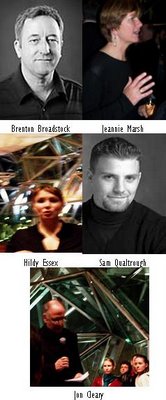
Miss Eagle is searching for words to describe what she experienced last night at BMW Edge at Federation Square. Via Crucis: Stations of the Cross, a choral work by Brenton Broadstock, was presented and performed by Australian Contemporary Chorale.
This was not a static event. Stations used not only voice - but minimal costume, movement, lighting, image, percussion and textile to bring to life and give contemporary meaning to an ancient reflection on events surrounding Jesus as he went to his crucifixion, death, and resurrection. Miss Eagle was so impressed, so caught up in the reverie and mystique portrayed, that it was only with great difficulty that her hands came together to join in the applause at the conclusion.
Originally, in ancient days, the Stations were performed in Rome to recall sad events that happened in another place. To bring this to remembrance, Broadstock's friend, Rome-based British artist Justin Bradshaw, produced a scene for each of the fourteen stations which were displayed for viewing as one entered the seating area. These paintings are reprinted in the program.
As one waited for the performance to begin, images were presented above the performance pit to remind us of those who stood up and spoke out to see wrongs righted. The images included Koiki Mabo, Ghandi, Martin Luther King, Emmeline Pankhurst, and Mother Teresa.
Two women need to take credit for the overall production. First is Hildy Essex who is the founder of the Australian Contemporary Chorale (previously known as the Melbourne Composition Choir) and its conductor. The Chorale's aim is to become the premier choir performing original Australian composition. The second is Jeannie Marsh. Jeannie's influence took this performance from chorale rendition into dramatic performance. The voices of Sam Qualtrough (tenor soloist) and Jane Hendry (soprano soloist) were a delight and brought richness and colour to the performance.
At the conclusion of the evening, Jon Cleary, the Australian religious broadcasters and commentator, launched the Chorale's CD, Stations.
And back to BMW Edge. From the seating, the audience looks across the Performance Pit, through the majesty of steel and glass, to the Yarra shimmering darkly under the city lights. Miss Eagle knows of only one better venue. It too sits beside water shimmering darkly at night under city lights - but at Bennelong Point.

